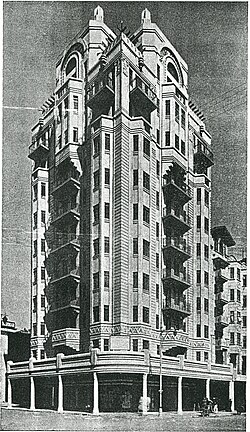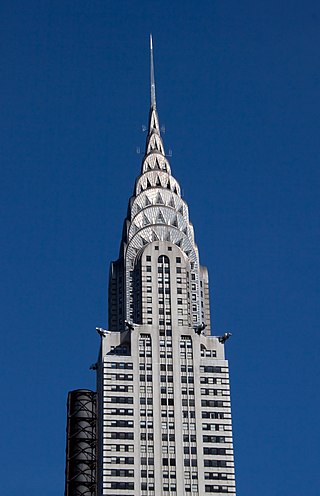
Art Deco, short for the French Arts Décoratifs, and sometimes just called Deco, is a style of visual arts, architecture, and product design, that first appeared in France in the 1910s, and flourished in the United States and Europe during the 1920s and 1930s. Through styling and design of the exterior and interior of anything from large structures to small objects, including how people look, Art Deco has influenced bridges, buildings, ships, ocean liners, trains, cars, trucks, buses, furniture, and everyday objects like radios and vacuum cleaners.
The Chrysler Building is an Art Deco skyscraper on the East Side of Manhattan in New York City, at the intersection of 42nd Street and Lexington Avenue in Midtown Manhattan. At 1,046 ft (319 m), it is the tallest brick building in the world with a steel framework, and it was the world's tallest building for 11 months after its completion in 1930. As of 2019, the Chrysler is the 11th-tallest building in the city, tied with The New York Times Building.

The Marble Towers is a skyscraper in the Central Business District of Johannesburg, South Africa. It was built in 1973 and is 32 storeys tall. The building has an eight-storey parking garage attached to it. The structure is made out of a mixture of concrete and marble.
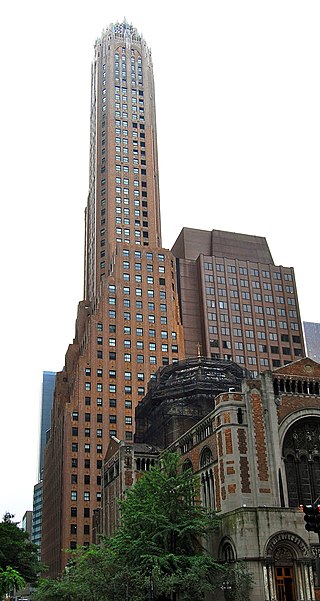
The General Electric Building is a skyscraper at the southwestern corner of Lexington Avenue and 51st Street in Midtown Manhattan, New York City. The building, designed by Cross & Cross and completed in 1931, was known as the RCA Victor Building during its construction. The General Electric Building is sometimes known by its address to avoid confusion with 30 Rockefeller Plaza, which was once known as the GE Building.

The David Stott Building is a 38 story high-rise apartment building with office space on floors 2-6 and retail space on the first floor. The "Stott" was originally built as a class-A office building located at 1150 Griswold Street in Downtown Detroit, Michigan, within the Capitol Park Historic District. It was designed in the Art Deco style by the architectural firm of Donaldson and Meier and completed in 1929. Bedrock Detroit owns and manages the building which began leasing in late 2018 and includes 107 apartment homes and 5 floors of commercial office space.

The El Dorado is a cooperative apartment building at 300 Central Park West, between 90th and 91st Streets adjacent to Central Park, on the Upper West Side of Manhattan in New York City. It was constructed from 1929 to 1931 and was designed by architect of record Margon & Holder and consulting architect Emery Roth in the Art Deco style. The El Dorado is 30 stories tall, with twin towers rising from a 19-story base. The building is a contributing property to the Central Park West Historic District, listed on the National Register of Historic Places, and is a New York City designated landmark.
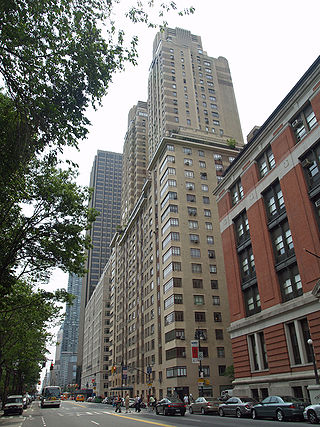
The Century is an apartment building at 25 Central Park West, between 62nd and 63rd Streets, adjacent to Central Park on the Upper West Side of Manhattan in New York City. It was constructed from 1930 to 1931 at a cost of $6.5 million and designed by the firm of Irwin S. Chanin in the Art Deco style. The Century is 30 stories tall, with twin towers rising from a 19-story base. The building is a contributing property to the Central Park West Historic District, listed on the National Register of Historic Places, and is a New York City designated landmark.

The Federal Office Building, Seattle, Washington is a historic federal office building located at Seattle in King County, Washington.
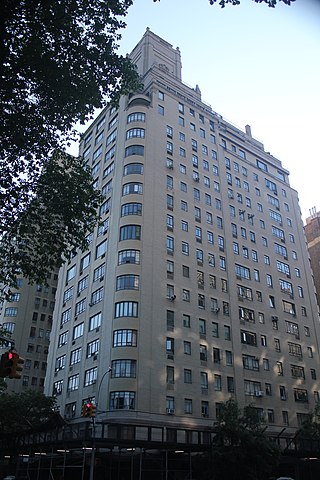
The Normandy is a cooperative apartment building at 140 Riverside Drive, between 86th and 87th Streets, adjacent to Riverside Park on the Upper West Side of Manhattan in New York City. It was constructed from 1938 to 1939 and was designed by architect Emery Roth in a mixture of the Moderne and Renaissance Revival style. The building was developed by a syndicate composed of Henry Kaufman, Emery Roth, Samson Rosenblatt, and Herman Wacht. The Normandy is 20 stories tall, with small twin towers rising above the 18th story. The building is a New York City designated landmark.

Yingli Tower, also known as Ying Li International Financial Centre is a skyscraper in the Jiefangbei CBD area of Chongqing, China. Its construction started in 2009 and was completed in 2012. It is an office building with a retail podium. In 2012 Yingli Tower eclipsed the Chongqing World Trade Center to become the tallest building in Western China, although this title was short lived since Chongqing Poly Tower received the title later in the year.
Anstey's Building is an art deco building in the city of Johannesburg. The building took its name from the original owner of the building, Norman Anstey, founder of one of the best known department stores in the city. The Norman Anstey and Company department store was housed in the four-storey podium of the building, which features a curved facade to address the street corner.
Arthur Oakley Coltman was an English architect practising in Malaya for 32 years where he worked as manager of the architecture firm Booty Edwards & Partners. He arrived in Malaya in 1925 and retired in 1957.

Manners Mansions was designed by the architectural firm of Emley and Williamson for African City Property Trust and was built in 1937-1939. The building is situated on stand 5198, at the corner of Jeppe and Joubert Streets in Johannesburg.

The Beacon Royal, also known as the Beacon Court, is an Art Deco block of flats constructed in 1934. This was a time of enormous growth as South Africa and the rest of the world emerged from the Great Depression. All over Yeoville and Bellevue in the years 1933 – 1934, blocks of flats were going up. The Beacon Court is located on stand 1044 at 55 Grafton Road/Louis Botha Avenue in Yeoville, Johannesburg. It was designed for PP Weisholtz by the brothers Obel and Obel who were also responsible for Astor Mansions in Jeppe Street and the Circle Court in Willie Street which overlooked Clarendon Circle at the time.
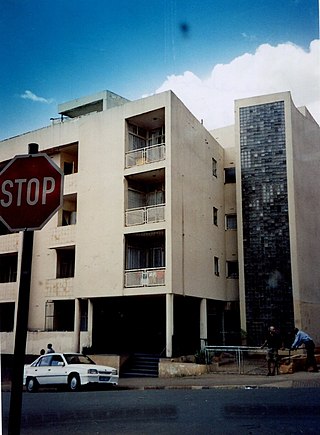
Radoma Court was designed in 1937 by the Harold Le Roith practice of architects. It is situated prominently on a corner site in Bellevue, at stand 474 where Cavendish and Yeo Streets meet.
Lauriston Court is a residential building in Houghton Estate, Johannesburg. The building was designed by the prominent architecture firm, Emley and Williamson and completed in 1936.

Murgon Civic Centre is a heritage-listed town hall at 62-70 Lamb Street, Murgon, South Burnett Region, Queensland, Australia. It is also known as Murgon Public Hall. It was designed by Clifford Ernest Plant and built in 1938 by HG Neilsen. It was added to the Queensland Heritage Register on 9 November 2012.
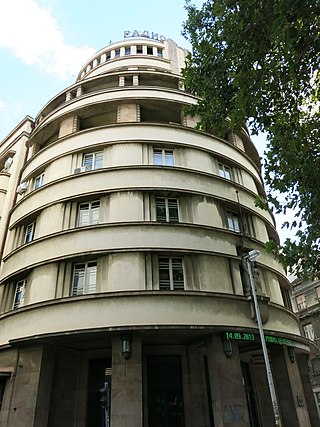
"Artisans Club" building in Belgrade is located in Belgrade, in 2, Hilandarska Street. It was built for the needs of the Craftsmen Association. It represents an immovable cultural property as a сultural monument.
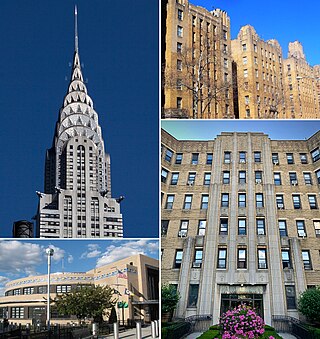
Art Deco architecture flourished in New York City during the 1920s and 1930s, before largely disappearing after World War II. The style is found in government edifices, commercial projects, and residential buildings in all five boroughs. The architecture of the period was influenced not just by decorative arts’ influences from across the world, but also the 1916 Zoning Resolution which influenced the setback feature in most of the buildings.
